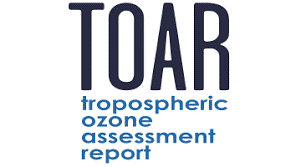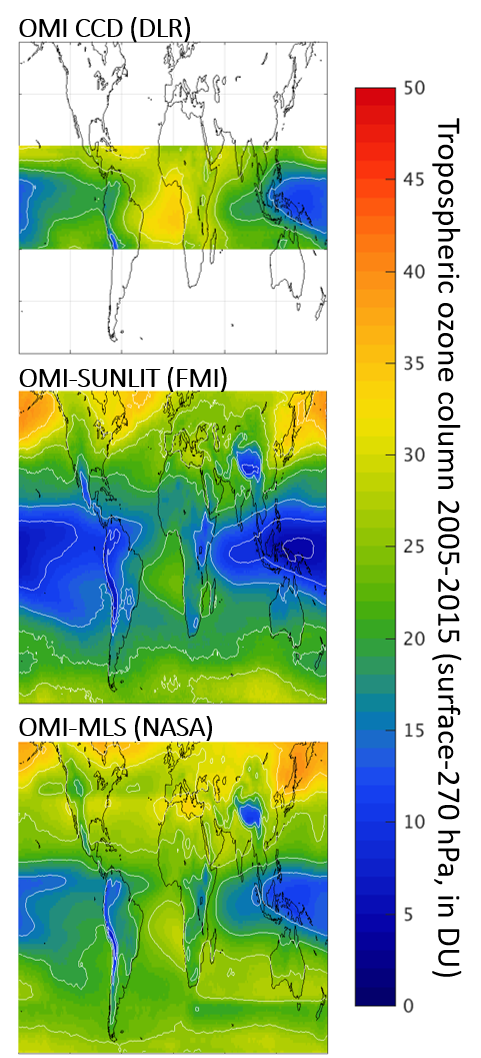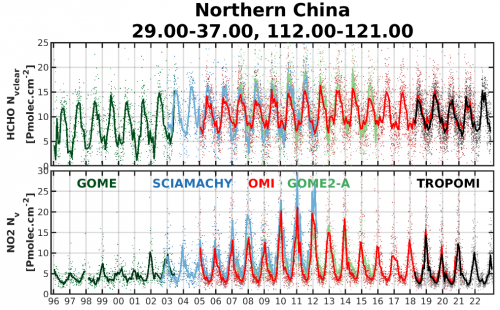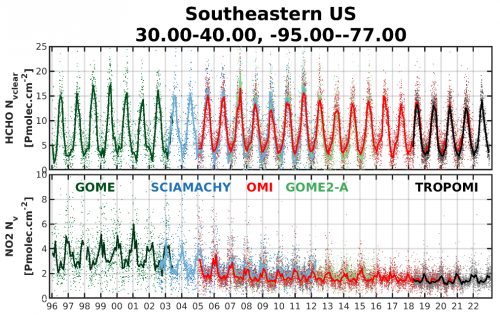
Robust assessments of changes in the global distribution of tropospheric ozone are a matter of concern for air quality monitoring and global warming. In this context, as of February 2020, TOAR (Tropospheric Ozone Assessment Report: Global metrics for climate change, human health and crop/ecosystem research) has entered its second phase (TOAR-II).
Our institute is involved in three ways.
1. Satellite ozone data
The Atmospheric Data Synergies group of BIRA-IASB, in collaboration with the SQUARES group at ULB, applies the harmonisation scheme of Keppens et al. (2019) to tropospheric ozone data records to account for differences in their vertical representation in terms of tropopause height, vertical smoothing, and prior contribution to the information content.
The tropospheric ozone data records provided by the three Metop/IASI satellite instruments are moreover reprocessed and homogenised in order to improve their internal coherence.
2. Ozone precursors and attribution of changes
Tropospheric ozone has increased in the northern hemisphere during the past two decades despite emission controls of ozone precursors such as NOx and VOCs. This rise seems to be partly caused by the increase of anthropogenic emissions in the tropics, where in situ measurements are sparse and satellite observations are therefore essential.
The solid experience of BIRA-IASB in satellite retrievals allows us to provide more than 25 years of harmonised HCHO and NO2 observations. This long dataset is based on multiple UV-VIS sensors, from the first GOME to the recent TROPOMI instrument, and supported by harmonisation, quality assessment and validation projects (QA4ECV and CCI + ozone precursors).
We are constantly improving the quality of those datasets and of their characterisation to support climate change and air quality studies.
3. Ground-based ozone and precursor data
BIRA-IASB is strongly involved in ground-based FTIR (Fourier Transform Infrared) retrievals of ozone and some of its precursors (HCHO and CO), which led to the harmonisation of ozone and HCHO datasets within the Network for the Detection of Atmospheric Composition Change (NDACC).
We contribute to the TOAR-II initiative by providing these harmonised and characterized data sets, which cover different latitudes (from the South to North Poles) and different pollution levels (from clean Arctic or oceanic sites to polluted cities). Some of the sites provide sufficiently long time-series to study the ozone and precursor (HCHO and CO) long-term trends.
Background on tropospheric ozone
Reference
- Keppens, A.; Compernolle, S.; Verhoelst, T.; Hubert, D.; Lambert, J.-C. (2019). Harmonization and comparison of vertically resolved atmospheric state observations: methods, effects, and uncertainty budget. , Atmospheric Measurement Techniques, Vol. 12, Issue 8, 4379-4391, DOI: 10.5194/amt-12-4379-2019.



